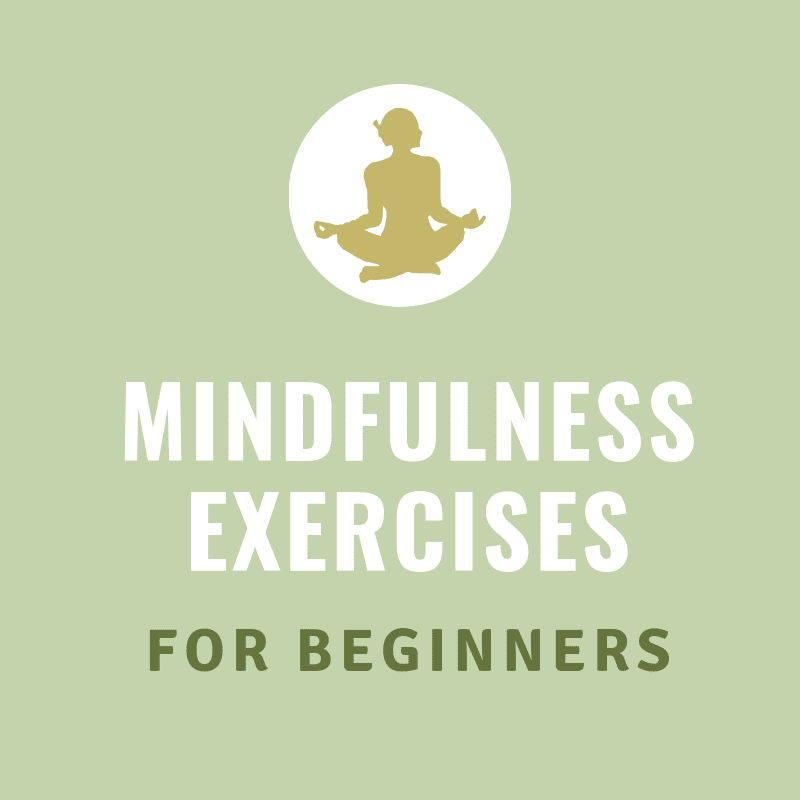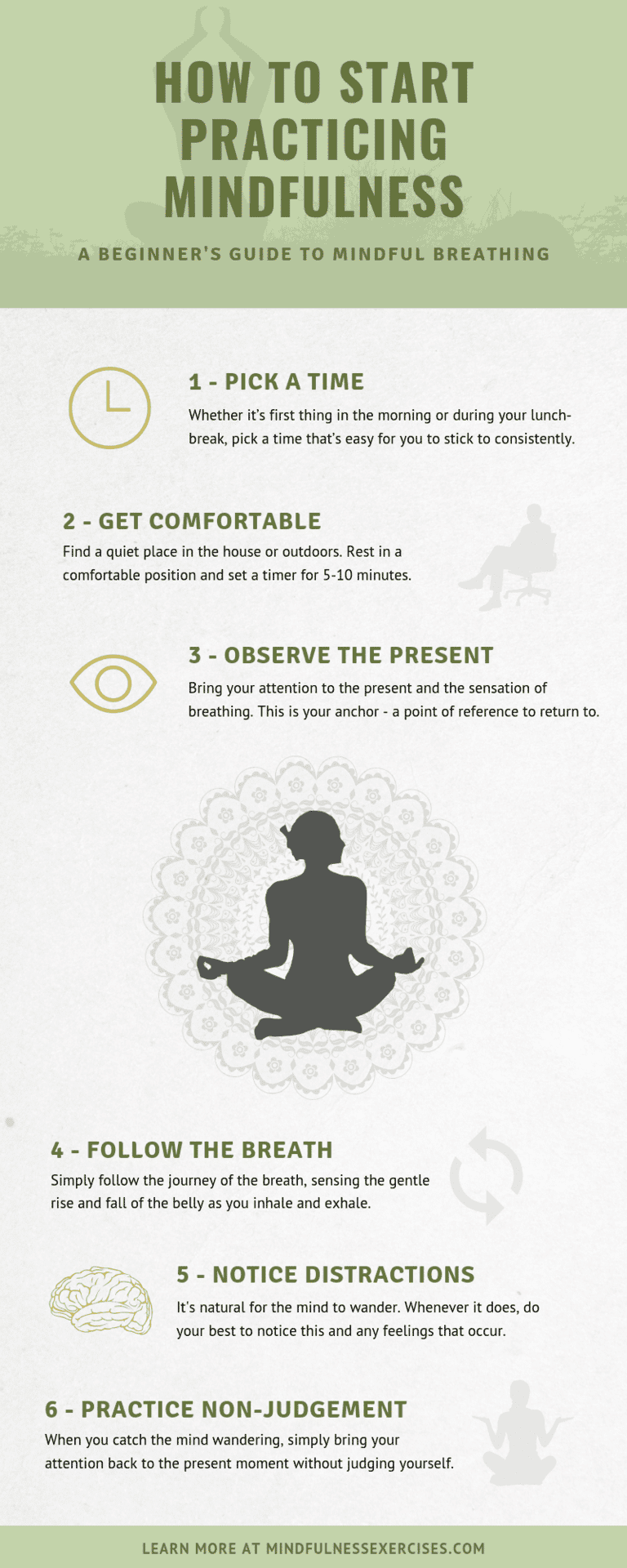This Mindfulness exercises for beginners infographic come in all shapes and forms. However, getting started with mindfulness is often easier said than done.
In an age where stress levels are high and productivity is king, more and more people are turning to mindfulness.
The problem?
Sifting through the sheer volume of information available today isn't always a simple task.
Fear not:
In this mindfulness beginners guide, we’re going to strip things back and provide everything you need to embark on your journey.
That includes 4 beginner Mindfulness Techniques that you can experiment with today, and plenty of further resources so you can dig deeper.

What is Mindfulness?
In simple terms, mindfulness is the art of being aware in the face of whatever is happening in the present moment.
It’s the practice of holding a sense of presence and non-judgment.
Contrary to popular belief, mindfulness isn’t about having a completely clear mind 24/7. It’s also not something reserved for lifelong meditation practitioners or ordained monks...
Getting started with mindfulness doesn't require special clothes, high tech equipment, incense, or any other complications.
Here’s the thing:
It can be practiced by anyone, at any time; there are no prerequisites required whatsoever.
In the video below, Jon Kabat-Zinn discusses what mindfulness and meditation are really about:
The presence of heart.
How Do I Start Practicing Mindfulness?
Mindfulness is a state of being that we’re ideally looking to cultivate in our everyday life. Whether that’s doing the dishes at home or sending an email at work.
However, to be able to effectively do this, a formal practice of some sort is often useful.
This can look different for each individual:
Meditation, mindful movement, mindful eating, and body scans are all valid forms.
There are many variations of mindfulness exercises for beginners, but regardless of the modality, the same six basic principles tend to apply:
Mindfulness Exercises for Beginners Infographic Guide

Share this Image On Your Site
1. Set aside a time to practice.
Having a regular time that you dedicate to cultivating mindfulness can help create a lasting habit. Whether it’s first thing in the morning or during your lunch break, pick a time that’s easy for you to stick to consistently.
2. Get into a comfortable position.
Simply find a quiet place in the house, at the office or on a park bench. Whether you're sitting, standing, walking or lying down, get into a comfortable position. Feel free to set a timer for 5-10 minutes.
3. Notice the inevitable distractions.
You can pick one of the mindfulness techniques for beginners listed later in the article or on the rest of the site, or simply choose to focus your attention on the sensations of breathing. This is your anchor - a point of reference that you try to return to whenever possible.
4. Sense the breath as best you can.
You can pick one of the mindfulness exercises for beginners listed later in the article or on the rest of the site, or simply choose to focus your attention on the sensations of breathing. This is your anchor - a point of reference that you try to return to whenever possible.
5. Notice the inevitable distractions.
Your mind will start to wander at some point. It’s totally natural and doesn't mean you're doing it wrong. Whenever it drifts, do your best to notice this and any judgments that may pop up as a result.
6. Bring your attention back to the present.
Every time you catch the mind wandering, simply bring your attention back to the present moment. Try not to judge yourself or beat yourself up. It’s not about sitting there with a clear mind! The practice is noticing distractions and gently returning to the anchor.
What are the Benefits of Practicing Mindfulness?
Although mindfulness isn’t typically pursued to achieve a particular goal, science has been able to demonstrate a wide range of potential benefits.
These include improvements in sleep, stress levels, anxiety, productivity, perceived happiness, and much more.
Listen to Dr. Richie Davidson discuss the modern science of mindfulness, where he highlights breakthroughs in neuroplasticity and how mindfulness influences both the brain and body, ultimately benefiting our health, genes, and well-being.
8 Mindfulness Exercises for Beginners
It’s no secret:
When you first dive into the world of mindfulness and begin searching for practices get started with, it can get a little overwhelming.
To make things easier for you, in this guide we’ve put together a bunch of beginner-friendly mindfulness exercises and meditations.
There’s something here for everyone. From simple breathing exercises and body scans, to listening exercises and mindful movement.
Give them a try and feel free to share them with loved ones if you feel they may benefit too!
One of the biggest obstacles people face when adopting a mindfulness practice is this:
Finding the time to fit it in amongst the craziness of everyday life.
The great news?
Mindfulness doesn’t have to mean hour-long meditation sessions every day.
Even just a few minutes of focussed breathing can make a tangible difference to your state of mind. You’re left feeling recharged and re-centered to go about your day.
Here’s how to get started with the two-minute mindful breathing:
[ai_playlist id=”197669″]
Two Minute Breathing Exercise Step by Step:
- 1Settle. Begin by taking a moment to settle in a comfortable position. You can close your eyes or look down to limit visual distractions.
- 2Relax. See if you can notice any areas of physical tightness or tension. That might mean dropping your shoulders, wiggling your fingers, loosening your jaw, softening the muscles around the eyes, or relaxing the belly.
- 3Check-in. Noticing where your body touches the ground or the chair. What does it feel like to have the weight of gravity pulling you down?
- 4Breathe. Inhale through the nose, and exhale through the mouth.
- 5Notice. Observe the pause in between each inhalation and exhalation. Notice the sensation of the air as it passes through the nostrils and mouth. You might even notice the belly rising and falling with each inhale and each exhale.
You can use this short meditation to recharge in the middle of a busy day, or you can stay with this process for as long as you like.
While many mindfulness exercises for beginners tend to use the breath as the main focus point, this doesn't always have to be the case.
Here’s the deal:
In the modern world, it’s easy to spend much of our time in completely tuned out of our body. Often times we only pay attention to it when we’re in pain or feeling hungry.
The body scan is a great way to check in and recalibrate our sense of self.
In fact, a 2017 study [1] showed that an 8-week body scan intervention was successful in improving interoception - the ability to sense the internal state of the body.
By scanning each part of your body, you create space for tense areas to relax. By the end of the guided meditation, you’ll likely feel more grounded and at peace.
If you struggle to drop off at night, it can also be used to wind down before bed to help you fall asleep faster.
The Body Scan Step by Step:
- 1Settle. Take a moment to settle in a comfortable position, finding a posture that allows you to feel relaxed but alert. You can be standing, sitting or lying down.
- 2Scan. We then begin to scan through the body:
a. Starting at the toes and feet.
b. Gradually move up through the ankles and lower legs.
c. Progress through the knees and thighs
d. Then scan through the pelvis, sit bones and lower torso.
e. Slowly move up through the torso, ribcage, and spine.
f. Observe the shoulders and shoulder blades.
g. Move down through the arms, wrists, and hands.
h. Finish by scanning through the neck, the face, and skull.
i. When you reach the very top of the head, hold the entire body in your awareness for one final observation. - 3Observe. Simply notice what you feel as you scan through the body, without judgment. Tap into the physical sensations, the skin, muscles, bones, and connective tissues. Gently note areas of tension and those that feel more open and relaxed.
- 4Avoid judgment. There’s no right or wrong, good or bad with the body scan. You’re just noticing what you can notice. Some areas may be more difficult to tap into than others, and you might sense differences from side to side. That’s perfectly fine!
The three mindful breaths exercise is more proof that introducing mindfulness into your everyday life doesn’t have to be complicated.
The premise is simple:
In the space of just a few mindful inhales and exhales, we’re able to take a step back from the hustle and bustle of the real world and cultivate a sense of awareness.
Here’s another free guided mindfulness exercise for beginners to get you started:
[ai_playlist id=”196423″]
Three Mindful Breaths Step by Step:
- 1Settle. Find a comfortable place, seated, standing or lying down. You can close your eyes or look down just to limit visual distractions. Notice the sensation of your sit bones on the chair or floor beneath you, or your feet on the ground.
- 2Breathe. Begin by taking a slow, gentle inhale, resting your attention on the sensation of air passing through your nostrils, filling your chest and abdomen. Notice the inhale ends, and shifts back through a gentle exhale. Notice the sensations in the body as the air passes back out. Rest for a moment and repeat for three total breaths.
- 3Reflect. What did that feel like? If you had to describe the sensations of breathing in those moments to somebody, how would you describe it? What temperature was the air? How long was each exhale? Was there a sense of ease, or a sense of trying to do it right? What was that experience like for you?
4. Mindful Walking Meditation
Some people find that seated mindfulness exercises aren’t always suitable for them.
This is often the case with people who deal with chronic pain or those who work sedentary jobs and want to avoid being static for prolonged time periods.
That’s where mindful movement exercises like walking can play an important role.
A 2013 study [2] showed that a 4-week mindful walking program resulted in reduced psychological stress symptoms and improved quality of life compared to a control group.
Here’s a simple explanation of walking meditation from Mark Coleman that you can experiment with:
Mindful Walking Step by Step:
- 1Find Space. Mindful walking can be performed indoors, but also works well out in nature.
- 2Check-in. Before you begin moving, perform a quick check in with your body. Notice the sensation of the soles of your feet on the floor and how your weight is distributed.
- 3Notice. As you slowly begin to walk, notice the sensation of your body as you move through space. You can also be aware of the noises and smells around you, but primarily focus on the feeling of your gait. Much like the breath is an anchor in a seated breathing practice, your footsteps become the anchor in walking meditation.
5. A Gratitude Meditation - Mindfulness Exercises for Beginners
Perhaps one of the most important benefits of a regular meditation practice is a heightened sense of gratitude.
A 2015 study [3] showed that both gratitude and mindfulness-based practices were associated with improvements in gratitude and happiness scores.
They also resulted in reductions in perceived stress levels - no doubt something that most of us could benefit from.
Gratitude Meditation Step by Step:
- 1Reflect on something small. Pick one simple thing to notice in this moment - whether internally or externally. It could be the sight of a tree in the distance. The feeling of a warm cup in your hand. Feel a sense of gratitude in your body for this.
- 2Reflect on a stranger. Someone you don't know personally, but has impacted your life in some way. It could be a bus driver, the greengrocer, or the author of the book you're reading. Again, invite a sense of gratitude towards this person.
- 3Reflect on the tools you use. Equipment you use in day to day life. Books, computers, equipment and even the building you occupy.
- 4Reflect on an acquaintance. Someone you work with or live with. Someone whose effort directly supports your experience of life. Appreciate their contribution, saying a silent thank you.
- 5Reflect on a loved one. Someone who makes your heart sing. Think about what this person means to you, and what you appreciate about them. Reflect on the impact they’ve had on your life. Notice any sensations this brings up in the body.
- 6Reflect on something you're grateful for today. Something that made a difference to you. The smile of a stranger, someone's kind words or a selfless act. Feel the appreciation and gratitude for this.
- 7Reflect on something challenging. If you feel comfortable to do so, bring to mind an experience that was somewhat challenging for you. Appreciate how that might have served as a learning experience.
- 8Reflect on yourself. Gratitude for your body, mind and the simple fact of being alive at this moment. Appreciate the countless gifts and opportunities in your life, and the experiences you’re able to enjoy.
At first, this one may seem a little out of the ordinary…
However:
It’s a viable mindfulness exercise for beginners and more advanced practitioners. It’s commonly used in the worldwide Mindfulness-Based Stress Reduction course pioneered by Jon Kabat Zinn.
The raisin drill is a great way to turn a seemingly ordinary experience into an opportunity to develop awareness. It’s also an excellent reminder of the benefits of slowing down when we eat.
It’s common for us to go through the motions at mealtimes, wolfing down our food without a second thought to how it tastes or makes us feel.
As a result, we tend to miss out on hidden flavors, and may even find our digestion suffers too.
So grab two raisins and a glass of water, and get ready to experience dried fruit in a completely different way...
Mindful Eating Step by Step:
- 1Begin with a short breathing meditation. Settle in a comfortable position, noticing the sensations of the breath. Take a few minutes to pause and reset.
- 2Observe the raisin. Look at it as if you were an alien that’s discovered something entirely new. Notice the texture, color, and how the light reflects off it. How does the raisin smell? If you hold it up to your ear and run it through your fingers, what sounds does it make?
- 3Place the raisin in your mouth. Resist the temptation to chew it up and eat it right away. Roll it around your mouth, over your tongue, and around your cheeks. Notice how it feels.
- 4Gently break the skin. Notice the burst of flavor. Notice the temptation to want to chew it, but keep rolling it around your mouth.
- 5Slowly start to chew. Take small bites, noticing the flavor. Notice how it starts to break up into smaller pieces. Feel the textures, experiences the flavors and hear the sounds.
- 6Sip your water. As the raisin pieces eventually disintegrate, take a small sip of water and notice the cool sensation in your mouth.
- 7Repeat the same process. Take the second raisin and repeat the same process, noticing the differences between the two experiences.
Anxiety, stress and sleep issues are three of the most common reasons one might initially turn towards a mindfulness practice.
The good news?
The science shows regular meditation can potentially be beneficial for all of the above:
The guided meditation below from Jason Stephenson is a little longer than others listed in this article but is highly rewarding if you can carve out the time.
Last but certainly not least, we come to a mindful listening practice courtesy of Alan Watts.
Listening is sometimes described as a lost art. With so much focus these days put on productivity and busyness, it’s rare us to take time to simply be still and listen to what’s going on around us.
However, the potential value of doing just that is immense. Not only does being a good listener improve your communication skills, it may also help you be more present in everyday life.
One of the main takeaways from the meditation below is this:
The stream of sounds that occur around us is comparable to the stream of thoughts going through our minds. The process for becoming more at peace with each is actually very similar.
Mindful Listening Step by Step:
- 1Settle the body. Get into a comfortable position and tune into the body - the sensation of the breath and your contact with the ground.
- 2Let sounds pass through. Practice noticing the sounds around you without labeling or judging them. Don't try to make sense of the sounds. Simply allow them to happen.
- 3Let thoughts pass through. As thoughts inevitably begin to arise, view them in the same way you view the sounds occurring around you. They come and go, and you don't need to attach a label to them or try to interpret them.
Your Next Steps:
- 1Get started with mindfulness. Pick one or two mindfulness exercises listed in our mindfulness beginners guide and experiment with them.
- 2Share your experience. Let us know how you get on and feel free to ask any experiences in the comments section below.
- 3Try our free 100-day mindfulness challenge. Daily mindfulness meditations, worksheets, and infographics to help you start each day mindfully.
Further Mindfulness Resources:
About Me


Sean Fargo
Mindfulness Exercises Founder
Sean Fargo is a highly sought-after teacher and speaker on the topics of mindfulness, meditation, and well-being. He regularly teaches CEO’s, celebrities and large groups around the world. In addition to speaking to executives at Fortune 500 companies and at various events, he leads an internationally accredited Mindfulness Teacher Certification Program.
References
1 Fischer, D., Messner, M., & Pollatos, O. (2017). Improvement of interoceptive processes after an 8-week body scan intervention. Frontiers in human neuroscience, 11, 452.
2 Teut, M., Roesner, E. J., Ortiz, M., Reese, F., Binting, S., Roll, S., ... & Brinkhaus, B. (2013). Mindful walking in psychologically distressed individuals: A randomized controlled trial. Evidence-Based Complementary and Alternative Medicine, 2013.
3 O'Leary, K., & Dockray, S. (2015). The effects of two novel gratitude and mindfulness interventions on well-being. The Journal of Alternative and Complementary Medicine, 21(4), 243-245.
4 Orme-Johnson, D. W., & Barnes, V. A. (2014). Effects of the transcendental meditation technique on trait anxiety: a meta-analysis of randomized controlled trials. The Journal of Alternative and Complementary Medicine, 20(5), 330-341. Mindfulness exercises for beginners.
5 Martires, J., & Zeidler, M. (2015). The value of mindfulness meditation in the treatment of insomnia. Current opinion in pulmonary medicine, 21(6), 547-552.


















